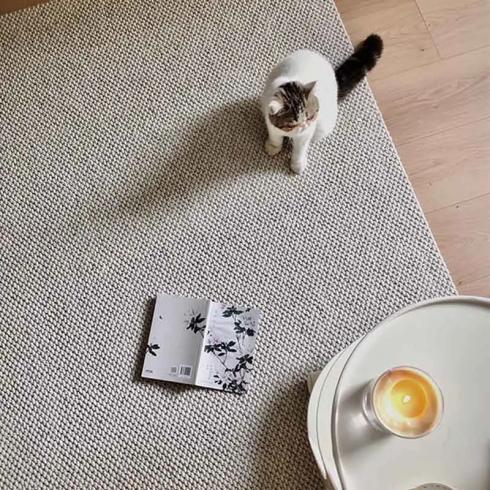In the world of commercial and hospitality design, the choice of flooring is a pivotal decision. It’s not just about aesthetics; it’s about durability, comfort, and long-term value. One option that consistently rises to the top for its blend of natural beauty and robust performance is wool loop pile carpet. This article will delve into what makes this type of carpet a superior choice for a variety of professional settings.
Why Wool Loop Pile Carpet is an Ideal B2B Flooring Solution
Wool loop pile carpet is created by weaving wool fibers into uncut loops, which results in a distinct texture and exceptional resilience. This construction method, combined with the inherent qualities of wool, makes it a prime candidate for commercial spaces.
The Key Advantages of Wool
Natural Durability and Resilience: Wool fibers have a natural crimp that acts like a spring, allowing the carpet to bounce back from foot traffic and furniture indentations. This means it maintains its shape and appearance in high-traffic areas, reducing the need for frequent replacement.
Superior Stain and Soil Resistance: The natural lanolin in wool provides a protective layer, making it resistant to spills and dirt. When spills do occur, they tend to sit on top of the fiber rather than soaking in, making cleanup much easier.
Exceptional Fire Resistance: Wool is naturally flame-retardant and self-extinguishing. It doesn’t melt or drip, making it a safer option for commercial environments where fire safety is a critical concern.
Natural Air Purifier: Wool fibers can absorb and trap volatile organic compounds (VOCs) and other airborne pollutants, helping to improve indoor air quality. This contributes to a healthier environment for employees and clients.
Excellent Acoustic Properties: The dense loops of a wool carpet are highly effective at absorbing sound, reducing noise levels from footsteps and conversation. This is especially beneficial in open-plan offices, conference rooms, and hotel corridors.
Sustainable and Renewable: Wool is a natural, biodegradable, and renewable resource. Choosing wool loop pile carpet demonstrates a commitment to sustainable business practices.
Why the Loop Pile Construction Matters
The loop pile structure is not just a design choice; it’s a functional one. Unlike cut pile carpets, which have exposed fiber ends, loop pile carpets have a uniform, dense surface. This construction provides several benefits:
Longevity: The continuous loops are less prone to crushing and matting, ensuring the carpet looks new for longer.
Ease of Maintenance: The tight weave of loop pile carpet makes it easier to vacuum and clean, as dirt and dust don’t get trapped deep within the fibers.
Defined Aesthetics: The structured surface of a loop pile carpet can create a clean, minimalist look that is well-suited for modern corporate and hospitality designs.
Case Studies and Applications
Wool loop pile carpet is highly versatile and can be used in a variety of B2B settings:
Corporate Offices: Its durability and professional appearance make it an excellent choice for meeting rooms, executive offices, and reception areas.
Hospitality: Hotels and resorts favor wool for its luxury feel, acoustic benefits, and long-lasting performance in lobbies, hallways, and guest rooms.
Retail: High-end boutiques and retail spaces use it to create a sophisticated atmosphere while withstanding constant foot traffic.
Educational Institutions: Libraries and common areas benefit from the noise reduction and durability of wool.
Conclusion
When selecting a flooring solution for your business, wool loop pile carpet stands out as a smart, long-term investment. Its combination of natural strength, aesthetic versatility, and practical benefits—from sound absorption to fire safety—makes it a superior choice that delivers both performance and value. It’s a decision that not only enhances the physical space but also aligns with a commitment to quality, sustainability, and well-being.
FAQ
Q1: Is wool loop pile carpet more expensive than synthetic options?
While the initial cost may be higher, the long-term value often makes wool more cost-effective. Its superior durability and resistance to wear mean it needs to be replaced less frequently, resulting in lower total ownership costs.
Q2: How do you clean and maintain wool loop pile carpet in a commercial setting?
Regular vacuuming is key. For spills, blotting immediately with a clean cloth is recommended. Most manufacturers provide specific cleaning instructions, and professional deep cleaning is advised periodically to maintain the carpet’s appearance and longevity.
Q3: Can wool loop pile carpet be used with underfloor heating?
Yes, wool is a natural insulator but also a good conductor. When properly installed, it is perfectly compatible with underfloor heating systems. It helps to retain heat, which can lead to energy savings.
Q4: Does wool loop pile carpet come in different designs and colors?
Absolutely. Wool can be dyed in a vast range of colors, and the loop pile construction allows for various patterns and textures. It is available in broadloom rolls and tiles, offering flexibility for custom designs and installations.
Post time: Sep-11-2025












